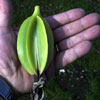|
|
|
|
|
| |
Flasks of
Cattleya mossiae var. reineckiana 'MC651' × self |
|
| |
|
|
| |
| Number: |
TN1791 |
| Name: |
Cattleya mossiae var. reineckiana 'MC651' × self
|
| Type: |
self (What's that?) |
|
Seed Donor: |
Dale Borders
|
|
Click to Enlarge

Pod Parent Flower |
Click to Enlarge

Pod Parent Blooming Plant |
Click to Enlarge

Pod Parent Capsule at 189 Days |
Click to Enlarge

Pod Parent Closeup of Labellum |
|
|
|
| |
Culture Notes from Donor: Parent plant: Temperature range I (60-83°F)
Comments: A very large flowered and extravagant variety.
For additional origin/habitat information supplied courtesy of
Charles and Margaret Baker, see further below, near the bottom of this page.
|
Temperatures we attempt to use in the lab & greenhouse:
| For Species: |
|
Spring, Summer, Autumn: days average 77°F, nights 60°F; best fit is Cool-Intermediate 75-58°F
(Source:
Baker's Web OSC) |
| For Species: |
|
Winter: days average 75°F, nights 55°F; best fit is Cool-Intermediate 75-58°F
(Source:
Baker's Web OSC) |
| For Genus: |
|
Spring, Summer, Autumn, Winter: days average 83°F, nights 60°F; best fit is Intermediate 83-60°F
(
) |
|
About the name...
| Etymology of |
Cattleya |
|
Named in honor of William Cattley, English horticulturist in the 19th century.
(Source:
Pridgeon 1992) |
| Etymology of |
mossiae |
|
Named for Mrs. Moss, English orchid enthusiast, during the 19th
(Source:
Mayr & Schmucker 1998) |
| Etymology of |
reineckiana |
|
Named for Eduard M. Reineck German collector in Brazil.
(Source:
Mayr & Schmucker 1998) |
| Pronunciation of |
Cattleya |
|
KAT-lee-ya
(Sources:
Pridgeon 1992, Hawkes 1978) |
| Pronunciation of |
mossiae |
|
MOSS-ee-eye
(Source:
Hawkes 1978) |
| Pronunciation of |
reineckiana |
|
rye-nek-ee-ah-na
(Source:
Hawkes 1978) |
|
If you would like to direct someone to this web page, please copy and paste this URL into your email:
http://troymeyers.com/d?011791
| Flask Information |
| Availability: |
Seed not viable- failed. We were not able to make any flasks. |
| You should: |
Consider placing a "Notify Retries" Request, and if an identical pollination (the same parents) is done again, we'll let you know. |
|
You might also want to:
|
View the seed assay for this item.
View items of the same species.
View items of the same genus.
|
| Ordering Information |
| You are not currently logged in. |
|
You must be a registered user and be logged in to reserve a flask or place a notification request. Please log in:
|
|
|
|
|
|
| |
The origin/habitat information below is supplied courtesy of Charles and Margaret Baker
The following information is based on the name of the plant provided by the donor, and assumes that the name is correct. If the plant has been misidentified, then the following information may not be correct.
This text is copyrighted by the Bakers and may not be reproduced without permission.
ORIGIN/HABITAT: Venezuela. Plants grow at 2950-4900 ft. (900-1500 m) in
the intermediate to cooler parts of the coastal mountains westward from
the State of Anzoategui to the extreme eastern part of the Andes in the
State of Lara. It reportedly grows in patches of cloud forest on the
north-facing slopes, but in recent years, according to Dunsterville, it
has been found primarily on the south-facing slopes where the forests that
still exist are not true cloud forest.
More about this information and the Bakers...
|
|
|
| |
|
|
|